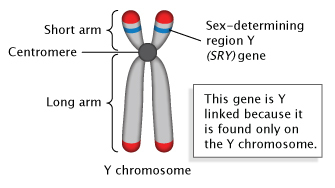Syllabus: GS3/ Science and Technology
Context
- Recent studies have uncovered exceptional cases where individuals with the SRY gene have developed as females, highlighting the complexities of genetic influence on gender determination.
The SRY Gene (Sex-determining Region Y)
- The SRY gene on the Y chromosome determines if a baby will be male or female.
- If the SRY gene is present, the baby will develop male characteristics and if the SRY gene is absent or mutated, the baby will develop female characteristics.
- The SRY gene produces a protein that attaches to DNA and controls the activity of other genes.
- The SRY protein starts processes that cause the fetus to develop male gonads (testes) and prevents the development of female reproductive structures.

Mechanism of Sex Determination
- Chromosomes: Each human cell has 46 chromosomes, or 23 pairs. One pair of these chromosomes is the sex chromosomes, which determine the sex of the individual.
- Female sex: Females have two X chromosomes, or XX.
- Male sex: Males have one X chromosome and one Y chromosome, or XY.
- Fertilization: When an egg is fertilized by sperm with an X chromosome, the resulting zygote will be female (XX). When an egg is fertilized by sperm with a Y chromosome, the resulting zygote will be male (XY).
Unusual Sex Development
- In rare cases, an SRY gene may be translocated from the Y chromosome to the X chromosome.
- If a baby inherits two X chromosomes, and one of them has the SRY gene, they usually develop male characteristics but are unable to have children.
- However, there are rare cases where individuals with two X chromosomes and the SRY gene develop as females.
- X Chromosome Inactivation: If a woman has the “male” gene (SRY) on one of her X chromosomes, that specific X chromosome (the one with SRY) is the one that gets turned off.
- This is because the SRY-carrying X is often missing other important genes, and turning it off prevents developmental issues.
Concluding remarks
- The SRY gene remains central to male sex determination, but rare genetic anomalies can lead to unexpected outcomes.
- The study emphasizes the need to examine translocation chromosomes for associated deletions that might influence gender outcomes.
- Understanding such genetic variations can help in medical counseling and diagnosing disorders of sex development (DSDs).
Source: TH
Previous article
Budgetary Allocation for Urban Development